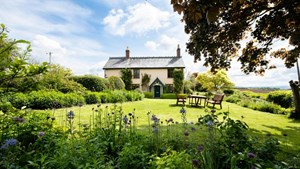Are older properties more expensive to insure?
11 minute read

The age of your property is one factor insurers will consider when calculating the cost of your home insurance. But there are plenty of ways you can help reduce the price of your cover, and enjoy the charm and character of an older home.

Over 50s Home Insurance
Age Co helps you protect the things you love. We’re 100% owned by Age UK and our profits go back to the charity.
Whether you’re looking to buy or currently living in an older home, it may be worth understanding how the age of your property could affect the cost of your insurance.
In this article, we’ll explain what constitutes an older property, which factors are considered when calculating the cost of your home insurance and what you can do to bring prices down.
What is an old property?
There is no hard-and-fast rule about when a property is officially considered “old”.
The term “older home” isn’t just for centuries-old stately homes. It can refer to any property more than 100 years old or built before the early 20th century, as architectural styles and construction methods changed significantly after the First World War.
How old is my home?
When figuring out the age of your home, architectural style can be a clue but it won’t necessarily reveal everything. Newer homes are often built in older styles.
If you’re trying to determine the age of your home, it’s best to look beyond the façade. Some of your best resources might include:
- Home surveys
- Title deeds
- Mortgage surveys or mortgage offers
- Property information forms
- HM land registry (should be able to provide information about your land but not always the structures that have stood on it)
- Local authorities
- Historical census responses
- Local archives and historical societies
Why can it be more expensive to insure an old home?
Age by itself won’t necessarily make an older home more expensive to insure, but insurers may have special considerations for older properties. At Age Co, we offer Home Insurance, provided by LV=. Here’s what their underwriting team says:
“Older builds are likely to have been built using different materials than what we use now,” says LV=’s underwriters. “So, the cost of repairing the building could be higher.
“This is because the repair may need specialist techniques and materials which could be harder to come by.”
Factors that can make older homes more expensive to insure
Non-standard construction insurance
From timber-frame Tudors to post-war prefabs, homes in the UK have not always been built to a single standard. Many homes fall under an insurer’s definition of non-standard construction.
Standard construction, for most insurers, is limited to the following materials:
- Main structure: brick or stone
- Roof: slate or tile
Insurers may include additional materials as standard for their own assessments but anything else – whether brutalist concrete or thatch – is generally considered non-standard.
Insurers tend to have less data on homes built using non-standard materials, so these homes can appear more risky – and subsequently be more costly to insure.
Asbestos risk
Older homes may also have been built with materials containing asbestos, a fibrous substance banned for use in construction in 1999. Direct exposure to asbestos can increase your risk of health conditions such as lung cancer and mesothelioma, and the presence of asbestos can increase your perceived risk level to insurers.
Asbestos removal must be carried out by trained professionals following strict safety protocols. The process can be costly and is rarely covered by insurance, but you may consider the lowered risks well worth it.
General maintenance
Older homes aren’t automatically at greater risk of maintenance issues, but years of wear and tear can make them more vulnerable to risk and consequently more expensive to cover.
Properties built to older standards for plumbing or electricity can be prone to faults or problems that, left unchecked, can become much more serious. For example, a claim for a burst pipe or a fire could really raise the future cost of your cover.
Repair and rebuild costs
Repair and rebuild costs for historically significant properties or those with non-standard construction can be much higher than those for new or standard builds.
Even small projects may require specialist tradespeople or hard-to-find materials – both of which can be costly.
An insurer will consider the cost of potential repairs or rebuilding when putting together a quote. High repair and rebuild costs can mean higher insurance costs.
Specialist cover
If your home is listed or has a particular non-standard feature such as a thatched roof, some insurers may not be able to offer you cover and you may need to seek a specialist.
A specialist insurer may understand the risks of an older home better than a traditional insurer and be able to offer cover more tailored to your situation.
What other factors can affect the cost of home insurance?
Insurers look at a variety of factors to assess the risk associated with insuring your home. Some of these include:
Location
Insurers use your postcode to check the number and types of claims made nearby, local crime rates and other statistics about the area.
This information can indicate whether you’d be susceptible to crime or likely to make similar claims, which could increase your perceived level of risk and the price of your home insurance.
Environmental risks
Older homes’ shallow foundations and many years in place can make them more susceptible to subsidence. Subsidence could increase your likelihood of making a claim and potential need for major repairs, both of which could increase your risk level and your insurance costs.
Depending on location, older homes may also be at risk of flood. You can check the gov.uk website to see if your property has a history of flooding as well as your long-term flood risk.
Security
Most older homes did not have safety or security features installed as standard. A lack of smoke or burglar alarms can leave homeowners exposed to the associated risks.
How to reduce the cost of insurance for an older home
If you’re looking for ways to bring down the cost of your insurance, here are some steps to consider:
Maintenance
Take care of small maintenance tasks as they arise and tackle larger projects proactively.
Make sure your roof is in good repair, wiring is working properly, pipes aren’t leaking or corroded, and damp and mould are managed. This may save you from larger repairs in the future and could help you save on insurance costs in the short term.
Security
Installing alarms for carbon monoxide, smoke or burglars potentially reduce your exposure to these risks – and could lower the cost of your insurance.
Find the right insurance for you
When looking for home insurance, it’s worth considering what features make sense for you and your home. While price is an important component, you want to make sure that, should the worse happen, you feel comfortable with the cover that will be provided.
For example: opting for voluntary excess will lower your annual or monthly home insurance costs. However, you should feel confident that you would be financially able to pay extra money towards your claim.

Over 50s Home Insurance
Age Co helps you protect the things you love. We’re 100% owned by Age UK and our profits go back to the charity.
Listed building insurance
Some older homes are also listed buildings. Listed status gives legal protection to architecturally or historically significant buildings. Similarly, a neighbourhood with architectural or historic significance can become a designated conservation area.
Listed buildings are graded as II, II* or I. Buildings in each grade are protected by restrictions around demolition and alterations, with those for Grade I being the strictest.
Repair, renovation and restoration work on listed buildings often requires the expertise of specialist tradespeople, or materials that can be difficult or costly to source.
As a result, listed properties can be more expensive to insure and may even require specialist protection.
Summary: what to consider when insuring an older home
Older homes can be more expensive to insure, but age is among the criteria insurers use to calculate your costs. If you are looking for insurance for an older property, keep in mind:
- There is no standard definition of an “older home”. Some older homes may be listed properties, which are architecturally or historically significant and given legal protection.
- Architectural style isn’t always the best indication of a home’s age – check official reports and historical archives for more definitive documentation.
- Insurers assess old homes for many of the same risks as new builds, but the age of old homes can mean that their exposure to these risks has been much more prolonged and pronounced.
Keep your home in good condition, install security measures and find the cover that fits your needs to improve your chances of paying the right price for the right policy – for you and your older home.

Sign up to the Age Co Newsletter
Each month, our email newsletter delivers inspiring stories, practical guides to later life, plus the latest news about Age Co and the charitable work we support.
